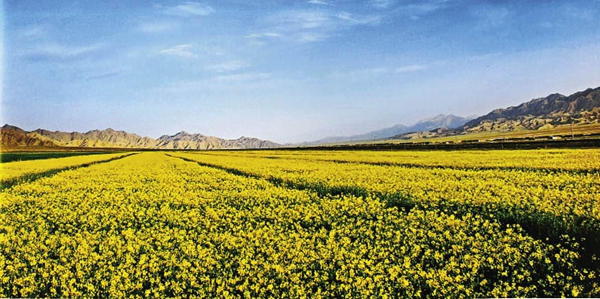Haixi: Industrial Upgrading through Development of a Circular Economy
China Today, November 10, 2016 Adjust font size:
Located in one of China’s less economically developed regions, Haixi Mongolian and Tibetan Autonomous Prefecture, Qinghai Province, is grappling with the conundrum of how to attain rapid economic development through industrial restructuring while promoting ecological progress.
Upgrading Industry
Haixi Prefecture’s long history and diverse culture owe much to its location at the four-way intersection of Qinghai, Gansu, Xinjiang, and Tibet. A strategic gateway to neighboring countries from China’s northwest, Haixi has jurisdiction over two cities and three counties. The prefecture has a permanent population of 509,100, a migrant population of 160,000 who have lived in the region for at least a year, and a floating population of around 100,000 working for enterprises and construction projects. This includes 36 ethnic groups, which account for 32 percent of its total population, the majority of whom are Mongolian and Tibetan.

Goji berry production base.
Covering an area of 325,000 square kilometers (about 41.7 percent of the total province), the prefecture mainly consists of desert, semi-desert, and alpine meadow, with an average elevation of 3,000 meters. In 2015 its GDP stood at RMB 43.99 billion – an annual average growth of 10.1 percent – and its per capita GDP exceeded RMB 100,000.
In recent years, Haixi has set itself the goal of accelerating its circular economy and upgrading basic industry.
Achieving all this calls for comprehensive restructuring of basic industry, regarding products, technology and equipment, as well as environmental protection, thus enhancing its overall competitiveness. Haixi will hence strengthen enterprise cooperation, resource circulation and integration between its salt lake chemical, petro-chemical, coal chemical, and metallurgy sectors.
Regarding its salt lake chemical industry, Haixi will build a deep-processing industry chain, focusing on exploitation of such resources as potassium, sodium, magnesium, lithium, boron and bromine. This will create a vital salt lake industrial cluster worth more than RMB 100 billion. Haixi is also proactively building a national base of sodium carbonate and sodium hydroxide production.
To promote its petrochemical industry and expand its exploitation scale, the prefecture will build a 10-million-ton oil and gas field, consolidating the status of the Qinghai-Tibet Plateau as a strategic petrochemical base, and creating an industrial cluster worth RMB 50 billion.
With regards to its coal-based chemical industry, Haixi’s focus is on clean and efficient utilization that will support the development of its salt lake chemical industry. It will vigorously develop downstream products, and build coal exploitation, coal chemical industrial and byproduct utilization chains, so to build an industrial cluster with a value of more than RMB 100 billion.
Haixi is also optimizing the metallurgical industry in efforts to upgrade its traditional industries and nurture downstream supporting industries. It plans to build a gold industry with an estimated value of RMB 10 billion and a national leading nickel sector.
Industrial parks will play a key role in local industrial upgrading. Haixi has built two in Golmud and Qarhan, each with a total investment of RMB 100 billion, and four in Delingha, Da Qaidam, Uland, and Dulan, each with an investment of RMB 50 billion, to encourage technological innovation among enterprises in the industry chain, and boost low-carbon circular economic development.
Haixi will monitor the harmonious development of all enterprises, set up service platforms for small and medium-sized enterprises, and so strive to develop a real economy. By exploring crowd-funding and encouraging mass entrepreneurship to support rapid growth of medium-sized, small and micro enterprises, the prefecture will foster more local businesses to add impetus to its economic development.
Moreover, Haixi will accelerate brand building, cultivate brand-name products, and expand superior enterprise groups’ proprietary brands and core competitiveness.
The above ambitions all need infrastructure support. Haixi will carry out coordinated development of railways, highways, and civil aviation, and build an extensive modern transport system. This will include the Golmud-Dunhuang Railway, the Golmud-Korla Railway, the expansion of Golmud Airport, the Golmud-Lhasa Highway, the Golmud-Chengdu Railway, the Xining-Golmud Railway, and Dulan Airport.
The prefecture will strengthen the water supply infrastructure by building a hydro-junction, protecting water sources, regulating rivers, reconstructing irrigated areas, and improving urban flood control. These measures will resolve the uneven distribution of water resources and poor water conservation in certain regions, comprehensively guaranteeing flood prevention capability and rational allocation of water resources.
Haixi will also reinforce its power transmission capacity by building a transmission and transformation line between southeastern Xinjiang and its Yukai Township, an extra-high voltage electric transfer passage between northwestern Qinghai and central China, and smart power grids. It will extend the power system to include outlying industrial and mining areas, and upgrade the rural grid. Haixi will moreover intensify the construction of information infrastructure, and achieve full optical and 4G network coverage.